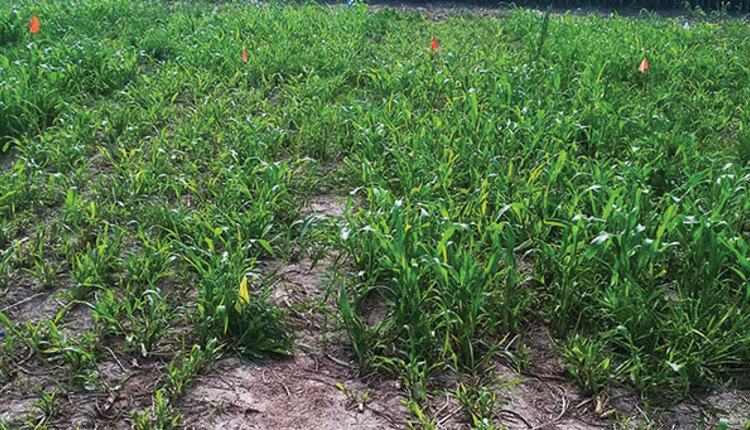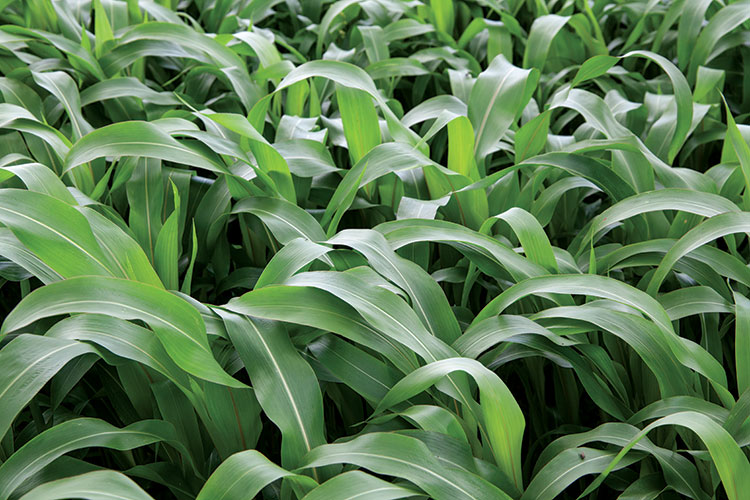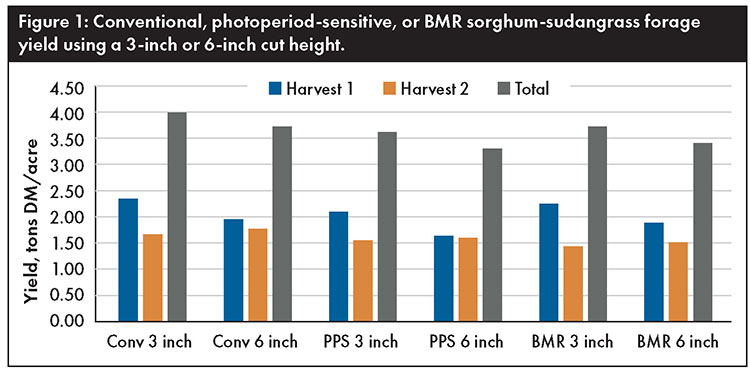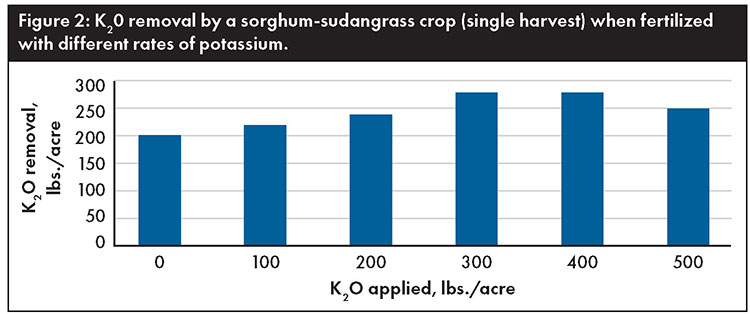Sorting out some sorghum decisions |
| By Matt Atkins |
|
Comparison of sorghum-sudangrass regrowth after a 3-inch or 6-inch cut height. |
|
The author is an extension dairy scientist with the University of Wisconsin-Madison.  Comparison of sorghum-sudangrass regrowth after a 3-inch or 6-inch cut height. In the past few years, there has been growing interest in warm-season annual forages, including forage sorghum, sudangrass, and sorghum-sudangrass. This is driven by more alternative forages being planted after a perennial crop winterkills, preferred use as beef cow and dairy heifer forage, and as a component in “cocktail” forage mixes. To address this interest, we have continued to initiate sorghum forage research centered on production practices and fertility needs. The past two years, we have examined how cutting height affects multi-cut yields and how potassium (K) fertilizer rates affect single-cut yields and K removal.  Warm-season summer annuals such as sorghum-sudangrass provide a good Plan B when a perennial crop winterkills. High or low cut? The typical cutting height recommendation for sorghum-sudangrass is to leave two nodes or about 6 inches of stubble to enhance regrowth. However, some recommendations suggest to cut lower in an effort to boost yields and promote tillering from plant crowns. We tested three sorghum-sudangrass hybrids with different traits: conventional, photoperiod-sensitive (PPS), and brown midrib (BMR). We planted in early to mid-June at 7- or 7.5-inch row spacings. The seeding rate was 18 pounds of live seed per acre with seeding rate adjustments made due to differences in germination rate. The first harvest was taken off leaving a 3- or 6-inch stubble height, and the second harvest was cut at 3 inches since regrowth was not expected. In 2019, harvests were taken in early August and again in October after a killing frost. In 2020, harvests were taken in late July and late August. Plant height at harvest ranged from 30 to 40 inches for the BMR and 40 to 60 inches for the conventional and PPS hybrids. In 2019, the Marshfield, Wis., plots had poor establishment due to high rainfall, which caused soil crusting. These field plots had to be abandoned. As expected, yields at Hancock, Wis., were better than Marshfield due to its drier soil conditions, and we harvested an additional 1 to 1.5 tons of dry matter (DM) per acre. Cutting height had minimal impact across both years and locations with about 0.25 tons greater total DM yield for the 3-inch cutting height.  Figure 1 shows a higher yield for the first harvest, but this was driven by a greater first harvest yield in 2019 that was taken later (early August with 50 to 55 days of growth) with less heat units available for later regrowth. In 2020, yields were more evenly distributed across the two cuttings in late July (40 to 45 days of growth) and late August (30 to 35 days of regrowth). There were differences in plant regrowth (see photo), with greater initial growth from stems from the 6-inch height and more tillering from the plant base for the 3-inch height. When using a shorter cutting height, consider that this may allow for more disease and plant death due to soil contamination of lower cut stems. We did observe some plant death for the shorter cut height, but it seemed to not affect the regrowth yield compared to 6-inch height. With the risk of plant damage and only a small improvement in yield at a shorter cutting height, a 6-inch cut height is still recommended based on these data. The higher cut would also likely result in greater forage quality, which we are currently evaluating. K is okay Potassium fertility recommendations are often high for sorghum forages. Using Wisconsin recommendations based on optimum soil test potash (K20) levels and a 5 to 7 tons per acre DM yield, the recommended amount of K20 fertilizer to apply is about 350 pounds per acre. In our study at the Marshfield Agricultural Research Station, we tested six rates of K20 fertilizer (0, 100, 200, 300, 400, 500 pounds per acre of K2O) using potash on a single-cut sorghum-sudangrass crop. The crop was seeded at 18 pounds of live seed per acre in 15-inch rows with a no-till drill and a total of 120 pounds of nitrogen per acre. We harvested in late October after a killing frost to maximize yield. Yields (8 to 9 tons of DM per acre) were similar across treatments, likely due to already optimal soil K levels. If we had done this work on low K soils, we may have seen some effect of fertility. There was a slight increase in forage K content, but the forage K levels were already low due to the crop’s mature state (1% to 1.5% K). When we looked at the K20 removal, we did see some boost in removal with added potash but only up to 300 pounds of K20 per acre (Figure 2). At this level, the removal rate (280 pounds) was close to the K20 applied and would maintain soil levels.  In 2020, we also evaluated using a multi-cut system, but once again, we noted no difference in forage yield. We are still working on mineral analysis to see if K levels increased. This data shows that sorghum-sudangrass will take up additional K as long as it’s available, but yield may not respond if soil K is adequate. Maintaining soil nutrients is important for subsequent crops as the soil will become depleted if nutrients are not added from manure or fertilizer applications. Single-cut boosts yields I also recently received questions about options for a single harvest of sorghum forages. This option maximizes yield but comes with the risk of snow and lodging when needing a killing frost for dry down. If planted by early June and with good growing conditions, we have observed that sorghums will mature and be dry enough for direct harvest by mid- to late October. Often this coincides with a killing frost, which helps to enhance dry down, but be sure to harvest after seven to 10 days to minimize prussic acid concerns. This strategy can work for early maturing forage sorghums or sorghum-sudangrass, but not with photoperiod sensitive hybrids. Another option that can work well is to plant sorghum-sudangrass in early to mid-June and allow it to grow until late August or early September, then harvest it by cutting and wilting for two to three days before chopping as silage. Wide-swathing is critical to help the leaves dry quickly, as the stems will likely not dry significantly. This option also opens up the ability to apply manure and plant a winter cereal grain forage crop (triticale or rye) for harvest the following spring. If you’re worried about lodging risk, this likely is a good choice for you. This article appeared in the March 2021 issue of Hay & Forage Grower on page 28 and 29. Not a subscriber? Click to get the print magazine. |
